 My colleague Sam Millette, senior investment research analyst on Commonwealth’s Investment Management and Research team, has helped me put together this month’s Market Risk Update. Thanks for the assist, Sam!
My colleague Sam Millette, senior investment research analyst on Commonwealth’s Investment Management and Research team, has helped me put together this month’s Market Risk Update. Thanks for the assist, Sam!
It’s time for our monthly look at market risk factors. Markets continued their upward climb in December, with the major U.S. equity indices hitting all-time highs during the month. Just as with the economy, however, there are several key factors that matter for the market in determining both the risk level and the immediacy of the risk.
Recession risk
Recessions are strongly associated with market drawdowns. Indeed, 8 of 10 bear markets have occurred during recessions. As we discussed in this month’s Economic Risk Factor Update, right now the conditions that historically have signaled a potential recession are not in place. There are, however, signs that risks are out there, with a weaker-than-expected jobs report and consumer confidence highlighting some of the risks. On an absolute basis, most of the major signals are not yet in a high-risk zone. But trends remain negative, and all five of the signals are at a yellow light. As such, we have kept economic factors at a yellow light for January.
Economic shock risk
There are two major systemic factors—the price of oil and the price of money (better known as interest rates)—that drive the economy and the financial markets, and they have a proven ability to derail them. Both have been causal factors in previous bear markets and warrant close attention.
The price of oil. Typically, oil prices cause disruption when they spike. This is a warning sign of both a recession and a bear market.

The price of oil jumped more than 20 percent on a year-over-year basis in December. But this jump was largely due to a sharp drop in oil prices last December that was quickly reversed. On a month-over-month basis, prices increased by a more modest 5 percent. With that being said, oil prices finished December at the highest absolute level since May and should be monitored given the increased political risk in the Middle East. Despite the uptick in December, prices remain well below recent highs seen in 2018. As such, we’ll leave this indicator at a green light for now.
Signal: Green light
The price of money. We cover interest rates in the economic update, but they warrant a look here as well.
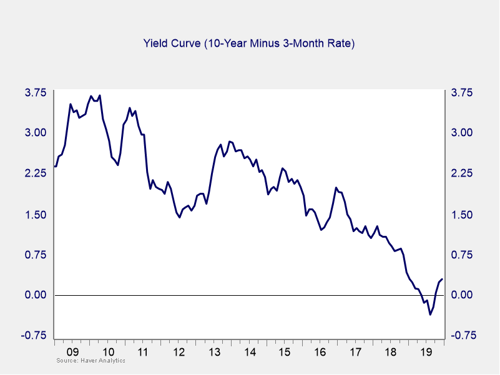
The yield curve continued to widen in December, as the yield on the 10-year Treasury note rose from 1.81 percent in November to 1.86 percent in December. The yield on the 3-month Treasury bill remained unchanged at 1.57 percent during the month. This marks the third straight month where the yield curve has remained un-inverted, which is how it normally functions. Despite this un-inversion, the risk of a recession in the future still remains, as historically we’ve seen recessions follow un-inversions of the yield curve within 12 months. There is also the chance that we will see another inversion in the short term, as a return to August’s recent low-water yields for the 10-year would leave us inverted. We are keeping this measure at a yellow light for this month.
Signal: Yellow light
Market risk
Beyond the economy, we can also learn quite a bit by examining the market itself. For our purposes, two things are important:
- To recognize what factors signal high risk
- To try to determine when those factors signal that risk has become an immediate, rather than theoretical, concern
Risk factor #1: Valuation levels. When it comes to assessing valuations, we find longer-term metrics—particularly the cyclically adjusted Shiller P/E ratio, which looks at average earnings over the past 10 years—to be the most useful in determining overall risk.
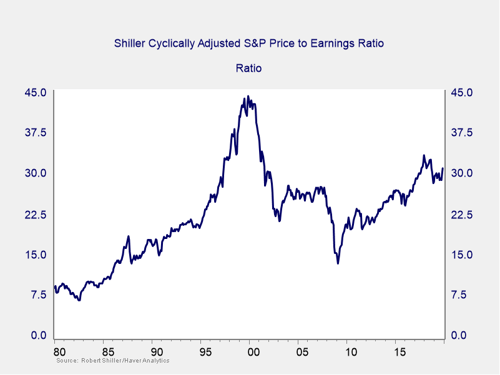
The major takeaway from this chart is that, with the run-up in 2019, valuations remain extremely high. They are still above the levels of the mid-2000s, although down from recent highs. Despite the drop, stocks remain quite expensive based on history. High valuations are associated with higher market risk—and longer-term metrics have more predictive power. So, this is definitely a sign of high risk levels.
Even as the Shiller P/E ratio is a good risk indicator, however, it is a terrible timing indicator. To get a better sense of immediate risk, we can turn to the 10-month change in valuations. Looking at changes, rather than absolute levels, gives a sense of the immediate risk level, as turning points often coincide with changes in market trends.
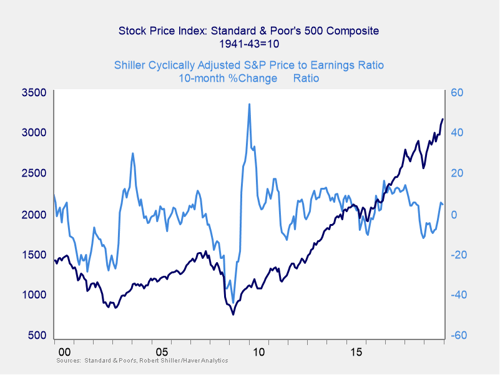
Here, you can see that when valuations roll over, with the change dropping below zero over a 10-month or 200-day period, the market itself typically drops shortly thereafter. After the decline at the end of last year took the market into the risk zone, recovery through this year has brought us positive for the year. December was another solid month for equities, marking four straight positive months following August’s volatility. We are keeping this indicator at yellow due to the fact that we remain above the levels of 2011 and 2015–2016. But with another month or two of improvement, this indicator could move back to green.
Signal: Yellow light (trending toward green)
Risk factor #2: Margin debt. Another indicator of potential trouble is margin debt.
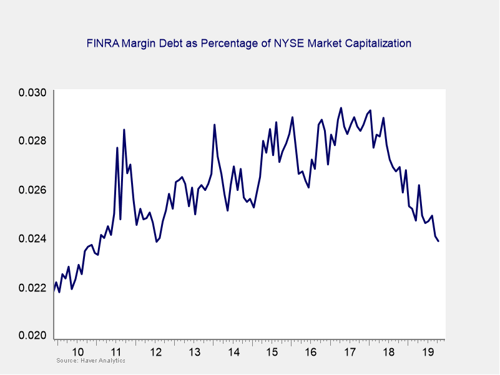
Debt levels as a percentage of market capitalization have dropped substantially over the past year, to close to the lowest levels of the recovery. Margin debt remains at the low end of recent history, but it remains high by historical standards. The overall high levels of debt are concerning; however, as noted above, high risk is not immediate risk.
For immediate risk, changes in margin debt over a longer period are a better indicator than the level of that debt. Consistent with this, if we look at the change over time, spikes in debt levels typically precede a drawdown. Margin debt as a percentage of market cap is well below highs seen in 2017 and 2018 and continued to fall throughout much of 2019.
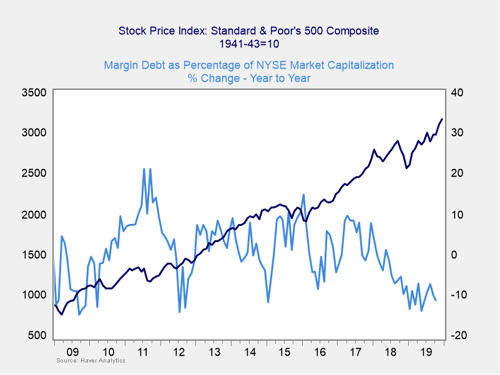
As you can see in the chart above, the annual change in debt as a percentage of market capitalization remains well below zero, as has been the case for the entire year. This indicator is not signaling immediate risk at this point but has been volatile in recent months. Given that, and the fact that the overall debt level remains very high, it is worth watching. So, we are keeping this indicator at a yellow light. Again, we are trending toward the lowest risk levels of the recovery from this indicator, so an upgrade to green may be only a couple of months away.
Signal: Yellow light
Risk factor #3: Technical factors. A good way to track overall market trends is to review the current level versus recent performance. Two metrics we follow are the 200- and 400-day moving averages. We start to pay attention when a market breaks through its 200-day average, and a break through the 400-day often signals further trouble ahead.
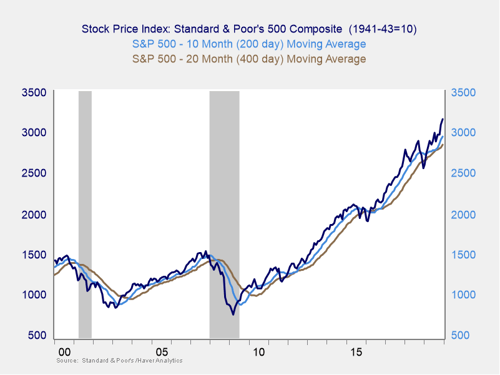
The decline at the end of 2018 took all three major U.S. indices below the 400-day trend lines, a significant support level. The subsequent recovery brought them back above both that level and the 200-day level. But in May, we had a brief break back below the 200-day trend line, followed by a recovery, and then another brief break below in June and further weakness in August. We’ve now had four straight positive months for markets following August’s declines, and a continued market rebound remains our base case. But as we saw in 2019, volatility can strike at any time. So, we are leaving this indicator at yellow for now.
Signal: Yellow light
Conclusion: Market risks moderate, but economic risks remain
Market risks have been at the yellow light level for the past 22 months and recently dropped even further with the hint of some red lights. But market conditions have largely improved over the past few months, despite turbulence at the beginning of December. On the other hand, economic risks have risen as the incoming data remains weak, and there have been a couple of potentially significant breakdowns. On balance, this leaves us solidly in the yellow zone of increased risks.
The market recovery to end the year following August’s volatility is encouraging, and the overall economic environment remains supportive. Although neither of the likely shock factors is necessarily indicating immediate risk, recent signs of economic weakness, combined with the fact that several of the market indicators continue to point to an elevated level of risk, suggest that volatility can appear at any time. As we saw over the past summer, outside factors can swiftly affect markets.
As such, we are keeping the overall market indicator at a yellow light. This is not a sign that risks have passed. Instead, it is a recognition that basic conditions remain supportive and that while risks are real, the most probable course is more appreciation—even though further volatility is quite possible.



 Print
Print

